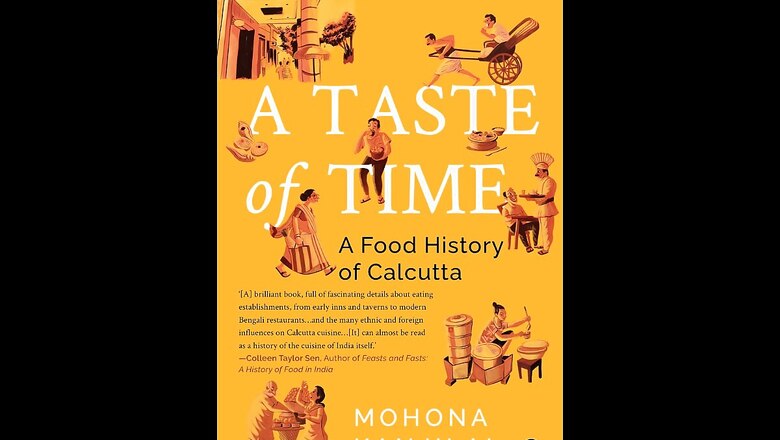
views
Before the arrival of the British, the local people used to consume fruits, whole or sliced. The concept of drinking fresh fruit juices was largely absent. At most, they sometimes indulged in the occasional daab (tender coconut water) sold by street vendors. Of course, sharbats, which were introduced into the country by the Mughals in the sixteenth century and popularized by Emperor Babur, were made in the city before fresh fruit juices began to take over. But sharbat (or sharbot, in Bengali) is a drink made from concentrated syrup that is prepared from sources like fruits, herbs and even flower petals. Cold water is mixed with the concentrate to make the drink, which happens to be a popular summer cooler. Sometimes, cold milk is used in the place of water for certain sharbat preparations. Spices, lime juice or dried fruits are often mixed into the sharbats.
The British introduced the practice of drinking fresh fruit juices at breakfast, tapping into the wide variety of tropical fruits found in India, but orange and sweet lime juices were easily the most popular amongst them. The practice of home juicing began in the city with their advent.
Aristocratic families were the first to pick up this habit from the British and began preparing and drinking fruit juices in their homes as well. The word spread and many adventurous people from different classes began trying this practice until gradually, natural fruit juices became a part of ordinary households and were commonly drunk for pleasure. The widely accepted nutritional value of citrus fruits was lauded and they were deemed to be tastier and much more refreshing to be consumed as juices than being eaten as whole fruits. Soon, it became a general assumption that fruit juices were good for health and they also came to be regarded as a ‘patient’s drink’. Anyone who fell sick was given a glass of fresh orange or sweet lime juice. The use of other fruits in juices developed much later amongst Bengalis.
ALSO READ | Quitting a Well-paying Job at Google for a Weekend Project at Home: How The Bohri Kitchen Was Born
Commercial production and sale of fruit juice was largely absent at first. Cashing in on the locals’ growing fondness for a glass of refreshing fruit juice, Paradise (now Paramount) was a prominent juice bar to open in the city. It attracted customers in droves and its success set the trend for the other juice bars to crop up over the decades. The city has also witnessed Kapila Ashram, another juice shop housed in an old building on Bidhan Sarani, serve an array of fruit juices to enthusiastic customers. Set up by Hrishikesh Srimani in 1907, it started functioning a few years prior to Paramount. Since its inception, Kapila Ashram has been a small and modest shop.
Unlike Paramount, which has proper seating arrangements, customers here had to drink their juices standing on the footpath. Yet, its regular customers simply loved the drinks it churned out. Today, the demolition of the old building has made the future of Kapila Ashram slightly uncertain. As of now, it is a kiosk on Bidhan Sarani that continues to serve juices to its loyal customers.
Paramount
This famous juice bar in central Calcutta has played host to some of the finest intellectuals of Bengal, since it opened in 1918, numbering poets, revolutionaries and professors amongst its clientele. Housed on Bankim Chatterjee Street near College Street (which has earned the nickname of ‘boi para’ or ‘neighbourhood of books’, due to the numerous book shops lining the street), it soon became a respectable venue for freedom fighters to meet and thrash out seditious plans of action, all the while maintaining the impression that the juice bar was nothing more than an innocuous place to enjoy a refreshing drink.
Its founder was Nihar Ranjan Majumdar, a physical fitness trainer by profession and one of the first to be drawn into the fruit-juice craze that affected Calcutta. To supplement his income as a trainer, he came up with the idea of starting a juice bar. Always experimental in his kitchen, Majumdar began stirring up combinations of ingredients to create a menu that was healthy while also being strikingly different from the juices one could make at home.
Paramount opened its doors to the public as Paradise, as it continued to be known till 1936. Professors, students and intellectuals visiting College Street flocked to it, intrigued by what the new place had to offer at first, and over the years, became loyal customers.
One of the oldest items served in the juice bar, daab sharbat is still the most popular. The recipe was given to Nihar Ranjan Majumdar by the brilliant scientist from Presidency College, Acharya Prafulla Chandra Ray. Hailed as the ‘Father of Indian Chemistry’, he established the first pharmaceutical company of India in Calcutta in 1901—Bengal Chemicals & Pharmaceuticals Ltd. Ray frequented the College Street area even after he left Presidency College in 1916 and began dropping in at Paramount. His daab sharbat is a juice made with the water of green coconuts, the tender sweet pulp found inside the fruit, and a few drops of an essence, which Paramount guards as a trade secret. The green coconuts used to make this drink have always been bought from Basirhat in North 24 Parganas, as the ones grown there have the sweetest water and very thin pulp. The recipe has remained unchanged since the days of its invention.
Majumdar followed up the grand success of daab sharbat with many others, based on further experiments in his kitchen.
As with most public eating places in that era, popularity depended on word of mouth, and Majumdar’s range of juices made from natural fruit extracts, home-made curd, fresh milk and cream, exotic nuts, secret syrups and essences made Paramount the talk of the town. Soon, revolutionary luminaries like Bagha Jatin, nationalist leaders like Netaji Subhas Chandra Bose, politicians like Dr Bidhan Chandra Roy, and literary intellectuals like Balai Chand Mukhopadhyay (who wrote under the pseudonym Banaphool) and Tarasankar Bandyopadhyay were dropping in to sample Majumdar’s creations.
ALSO READ | 500 Staff, 50000 Sq Ft Dining Halls, 1 Lakh Footfall: The Story behind Famous Langar at Golden Temple
The owners of Paramount continue to experiment with different ingredients to add new elements to their menu and the people of Calcutta continue to crowd it around the year. During the summer, customers cool themselves with litchi or tamarind juices, or a glass of either cream lemon or cream green mango. The latter, a sweet and tangy drink, was a favourite with prominent barrister, politician and former chief minister of West Bengal, Siddhartha Shankar Ray. During the rainy season, customers reach out for cream pineapple, while evenings, the year around, are dominated by grapes crush. To make this, green grapes are boiled with sugar at least three times and the pulp is then preserved in a jar for three months before it can form the base of this popular drink. Winters are ruled by the rich flavour of cocoa malai. This completely milk-based drink does not have a drop of water in it and is made with drinking chocolate and crushed ice, topped with a thick layer of khoya (also known as mawa) and sprinkled with dried fruits like cashews, almonds and raisins.
Read all the Latest News, Breaking News and Coronavirus News here.



















Comments
0 comment